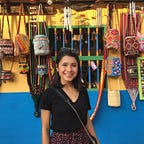Readee, set, go!
Part 2: Creating the MVP for a reading app.
Do you remember that post about well-being and reading goals? Here is the link if you missed it.
The goal
The goal of this project was to help people live a healthier lifestyle by incorporating daily habits into their routines. My colleague and I decided to tackle this subject from a mental health approach and we created a reading application that keeps the user motivated and engaged by setting reading goals throughout the year.
By the beginning of the second stage of our project (UI), we had the mid-fi of our app’s MVP and we had done usability tests with 5 people. The results were positive but the testers were having issues with three main things.
- The tracker and library navigation pictograms were not clear for them.
- The goal tracker page was confusing and needed a whole redesign.
- The recommendation feature needed to be improved.
We decided to fix these issues in the hi-fi prototype.
Visual benchmarking
Moving into the UI wireframing of our application we researched what our main competitors were doing visually. We found out reading applications in the market are pretty classic, nothing very cheerful or colorful. For us, it was almost too boring and it became clear pretty fast the visual path we wanted to follow.
After looking for inspiration on the web, identifying the visual styles we could adopt, and defining the brand attributes we wanted to reflect in our app, we created our moodboard.
We also started creating the style tile with the colors, the typefaces, the sizes, and the buttons we chose for the app. The color choices were made based on the feelings we wanted the user to experience when using this application.
Yellow: Happiness Orange: Excitement Blue: High-quality White: Sincerity
In the end, we added some components from the app and our style tile looked like this.
We moved to hi-fi wireframing and prototyping and incorporated the defined brand identity. When we were done we conducted usability tests with 5 people. 5 main things needed to be improved.
Iteration game on!
We iterated on those 5 issues and improved the application and the navigation flow.
Onboarding:
The user sets up his account, his reading goal, his notifications preferences, and his reading interests.
Homepage and reading process:
Once on the homepage, the user can navigate between different topics and reading collections based on his preferences.
He can check out a book card and know more about it.
During the reading process, he can highlight a passage and save it or share it. He can learn more about a passage by clicking in the eye icon and he can see his reading progress by taping on the screen.
When he has finished the book a little survey will be presented to get to know better his reading style.
Reading Goals:
The user will be able to check his goal in progress. The books he has read within this objective and the ones he’s currently reading.
He can also check out the goals he has achieved, and share one of the books he has read with a friend.
Book Club:
The book club feature aims to develop a social network around books, authors, and extracts.
Here the user can see what his friends are reading, which books and authors they recommend, like, comment, or share a post.
He can also check out an author’s card, see how many people have read his work, what are the books he has written and read his biography.
The low bar is the current book the user is actually reading and it is always visible so the user can start reading anytime during his navigation in the app.
Desirability testing
When we finished our hi-fi prototype we conducted a desirability test with 23 people. The main adjectives they gave to our app were: contemporary, intelligent, spirited, trendy, and cheerful. They match our initial brand attributes so we classified them in a brand personality table. We were delighted to see our application came up as being exciting and sincere and our goal of mixing fun and culture was accomplished.
Next steps:
After 2 weeks of really intense work, this is the first MVP of our application. There are still user flows that need to be defined, designed, and tested: the user profile, the library, the social networking feature, and the notifications. The next steps are adding these flows in the app’s MVP, doing more usability and desirability tests, iterating, defining the way to monetize the app, and moving to development.
Key learnings:
Creating and designing an application is not an easy job. It takes tons of hours of work, cups of coffee, time with users, and unlimited iterations. At the end of the presentation of our first MVP, we received feedback from our mentors and teammates and the main takeaway out of all this process is: there are always things to improve in a digital product.
If you wish to interact with our prototype here is the link .
Thanks for reading.
